 The ivory-billed woodpecker ( Campephilus principalis) -- is among the world's largest woodpeckers. Only the imperial woodpecker of Mexico, now thought by many to be extinct, was larger than the ivory-bill.
The ivory-billed woodpecker ( Campephilus principalis) -- is among the world's largest woodpeckers. Only the imperial woodpecker of Mexico, now thought by many to be extinct, was larger than the ivory-bill.
The ivory-billed woodpecker once ranged through swampy forests in the southeastern and lower Mississippi valley states: from North Carolina to Florida and west to eastern Texas and Arkansas, with some 1800s reports in Kentucky, Missouri and Oklahoma. John James Audubon reported ivory-bills as far north as the junction of the Ohio and Mississippi rivers around 1825.
a.. Description of the ivory-billed woodpecker:
Averaging about 20 inches in length, C. principalis is frequently mistaken for the smaller but similarly marked pileated woodpecker. Ornithologists distinguish the two by the location of the white wing feathers: the full-width white patch in the ivory-bill's trailing wing feathers (when seen from above) folds to form a white "saddle" on its back when the bird is perched. Males have a prominent scarlet crest; the female's crest is black.
b.. The ivory-bill's communication and flight:
Ivory-bills communicate with a vocalization that ornithologists transcribe as "kent, kent, kent" and with the "BAM-bam" double-rap of their bills pounding on wood. Their swift, arrow-like flight through trees resembles that of the pintail duck, unlike the slower, swooping flight of the pileated woodpecker. Stiff wing feathers make the ivory-bill an especially loud flyer. People who saw the impressive ivory-bill in flight could be forgiven for shouting, "Lord God, what a bird!" - explaining why the ivory-bill is also known as the Lord God Bird.
c.. The "Ivory" Bill
The "ivory" of the ivory-billed woodpecker is a keratin sheath over the bill of bone. The broad bill continues to grow from the ivory-bill's thick-boned skull throughout its life (potentially, up to 30 years) and is worn down by rigorous pounding on trees. d.. Habits and habitat of the ivory-billed woodpecker:
e.. Ivory-bills are believed to mate for life. They share the duties of incubating their china-white eggs and raising their young, which usually leave the parents' territory at the end of the season. A pair of ivory-bills is estimated to need six square miles of uncut forest, roughly 36 times as much territory as pileated woodpeckers require. Ivory-bills excavate trees to make nest holes (usually oval-shaped openings between four and six inches in size, extending 20 inches or more down into the tree, and 40 feet or higher above ground level).
f.. Food source of the ivory-billed woodpecker:
Beetle larvae are the primary food source for ivory-bills, which are often the first woodpeckers on dying trees searching for these larvae. When beetle larvae bore through the bark to feed on the sap wood beneath, ivory-bills use their elongated beaks to pry bark from the trees and expose the larvae.
(Image provided by the Nature Conservancy.)

all contents copyright © 2005, asheville.com. contact: [email protected] or 828.253.2880
For listing and advertising information...

 The ivory-billed woodpecker ( Campephilus principalis) -- is among the world's largest woodpeckers. Only the imperial woodpecker of Mexico, now thought by many to be extinct, was larger than the ivory-bill.
The ivory-billed woodpecker ( Campephilus principalis) -- is among the world's largest woodpeckers. Only the imperial woodpecker of Mexico, now thought by many to be extinct, was larger than the ivory-bill.
